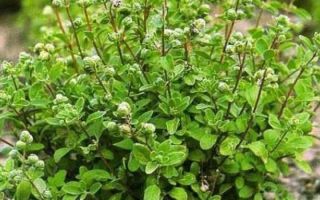Content
- 1 What does marjoram look like and where does it grow
- 2 Chemical composition of marjoram
- 3 What is the taste and smell of marjoram
- 4 Marjoram varieties
- 5 Why is marjoram useful?
- 6 Application methods
- 7 The use of marjoram seasoning for medicinal purposes
- 8 The use of spices in cosmetology
- 9 The use of a slimming spice
- 10 The use of marjoram in cooking
- 11 Contraindications to the use of marjoram herb
- 12 How to choose and store
- 13 Conclusion
- 14 Reviews of marjoram for weight loss
Useful properties of marjoram and contraindications must be studied in order to use the seasoning correctly and without harm to health. The herb has a very wide range of uses.
What does marjoram look like and where does it grow
Marjoram (Origanum majorana) is a perennial herb from the genus Oregano. Outwardly, it is a medium-sized shrub up to 75 cm tall with thin straight stems of a slightly lilac shade and small oval juicy green leaves. The culture blooms late, in July and August, brings small white or pinkish buds.

The perennial has low frost resistance and grows mainly in warm regions, where temperatures do not drop below 20-25 ° C. You can meet him in North Africa and Turkey, in the Middle East and Central Europe, in the Mediterranean countries.
Chemical composition of marjoram
The green parts of the plant contain a huge amount of nutrients. Among them are:
- borneol and linene;
- phenol;
- beta carotene and rutin;
- vitamins C and A;
- essential oils;
- cryptoxanthin-B;
- potassium and iron;
- terpinene and cymene;
- lutein zeaxanthin;
- calcium and zinc;
- linalool;
- eugenol.
Basically, the herb consists of carbohydrates - about 60 g, and proteins and fats take 12 and 7 g each. The calorie content of the seasoning is 270 calories, but it is impossible to get better when using marjoram, it is used in cooking in minimal dosages.
What is the taste and smell of marjoram
The seasoning has a very pleasant smell - fragrant, warm, vaguely reminiscent of sage. Woody notes are intertwined with citrus, the aroma has a subtle bitterness. The taste of marjoram is also slightly bitter, but not pungent, but rather tart.
Marjoram varieties
A perennial plant is divided into 2 main types:
- garden leaf, rises up to 50 cm and has a bright aroma;
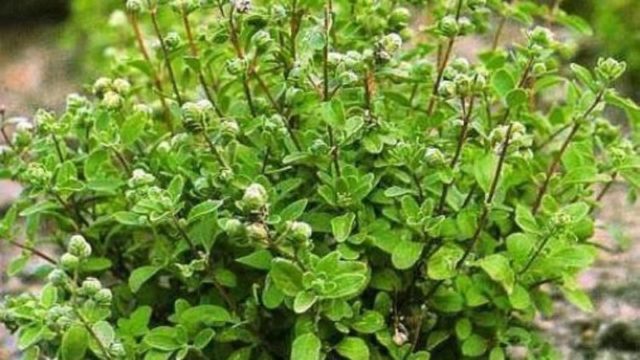 Marjoram leaf is most commonly used in cooking as a condiment
Marjoram leaf is most commonly used in cooking as a condiment - floral, does not exceed 20-40 cm, very abundantly produces buds in the middle of summer.
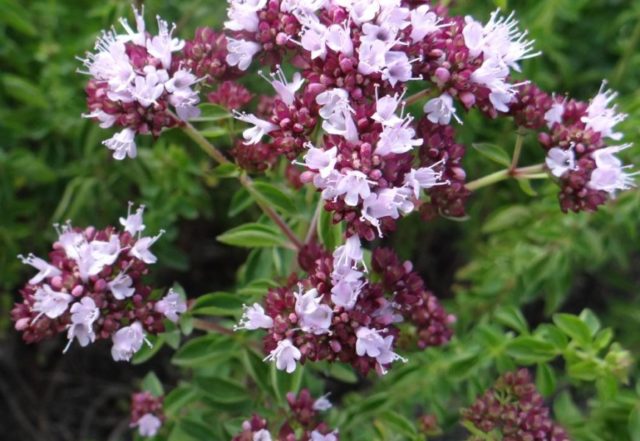 Floral marjoram is used to treat and prepare essential oil
Floral marjoram is used to treat and prepare essential oil
In addition, there are several popular crop varieties.
Scandi
A large branched shrub with light green leaves blooms with white buds. Suitable for use in both culinary and traditional medicine, it is equally useful in dried and fresh form.
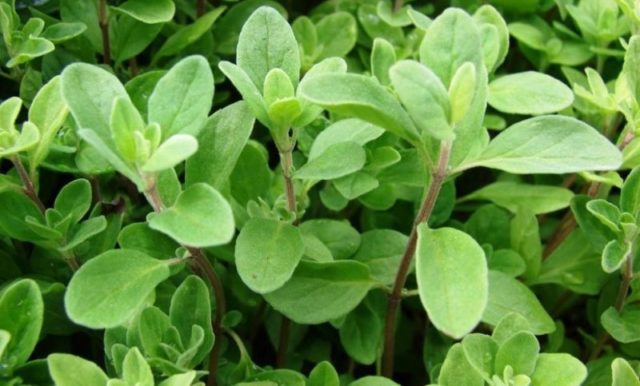
Thermos
The food grade of marjoram grows up to 40 cm and is distinguished by silvery or bluish leaves. It is actively used in cooking as a seasoning.

Cretan
In the photo, marjoram looks like a squat shrub with thick, dense leaves of a bluish tint. The flowers are unusual, large and hanging, light pink or purple. It has pronounced citrus notes, therefore, this seasoning is mainly added to tea.
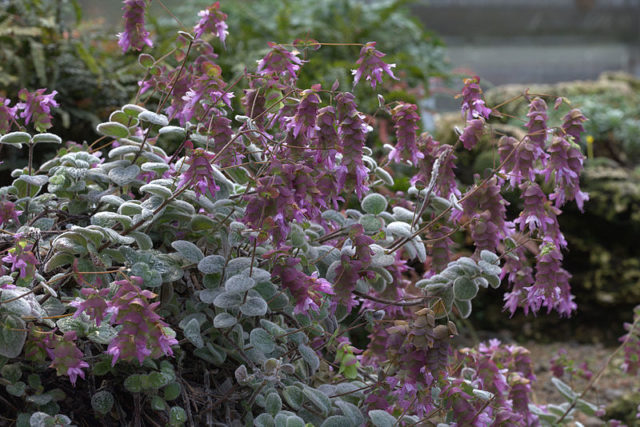
Baikal
The most popular culinary variety with a pronounced aroma. Marjoram Baikal grows up to 60 cm, its stems are tough and straight, the leaves are very thick, rich green.
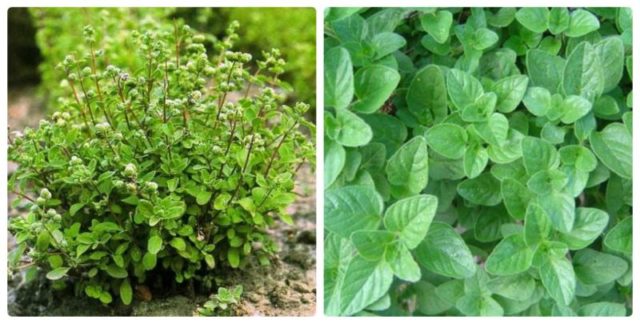
Gourmet
Low-growing marjoram with smooth leaves with a light silvery bloom. The variety Lakomka has a sweet taste and is often used in salads, sauces and sausages.

Why is marjoram useful?
Due to its rich composition, the seasoning brings great benefits to the body. When used correctly, it:
- improves the functioning of the stomach and intestines and regulates metabolic processes;
- helps to quickly cope with inflammatory processes in the body;
- reduces blood pressure and protects against hypertension;
- strengthens blood vessels and improves blood composition;
- relieves muscle tension and has a mild analgesic effect;
- takes care of the health of cartilage and joints;
- promotes weight loss due to fat burning properties;
- effectively helps with flu and SARS, the seasoning relieves a runny nose, cough and headache;
- benefits in dental diseases, protects enamel and disinfects the oral cavity;
- has a calming effect and helps to improve sleep;
- has a beneficial effect on hormones;
- relieves pain during menstruation and improves menopause in women;
- serves as the prevention of prostatitis and adenoma in men;
- positively affects the condition of the skin and hair;
- helps to strengthen the immune system in children.
Application methods
Seasoning is not only added to food, but medicines are also prepared based on it. Several recipes are most popular.
Tea
For colds, nervous stress and inflammation, marjoram-based tea is most often used. It is prepared like this - 1 small spoonful of fresh or dry seasoning is poured with a glass of boiling water and left for 5 minutes. After that, the drink can be consumed in small sips before or after meals, but the daily portion should be no more than 2 cups.
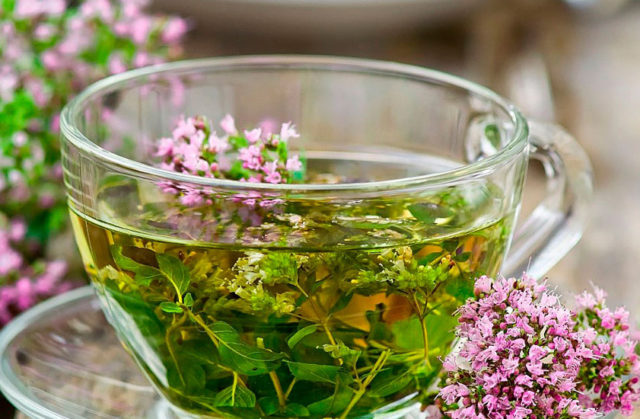
Ointment
Homemade ointment based on marjoram is made like this - 1 small spoonful of mashed seasoning is mixed with the same amount of wine alcohol. Then the mixture is infused for 4-5 hours, and then combined with an equal amount of butter and heated with steam for 10 minutes.
The finished viscous agent is passed through cheesecloth and cooled to obtain the desired consistency. The ointment can be used for joint ailments, it warms up tissues well, relieves local swelling and inflammation.

Oil
Marjoram oil is produced industrially using steam distillation, so the product can only be purchased at a pharmacy. It is used for aromatization of premises and for instillation into the nose for flu and colds, for massage and for inhalation. In minimal dosages, the essential oil can be used internally, for example, add 2 drops to green tea.
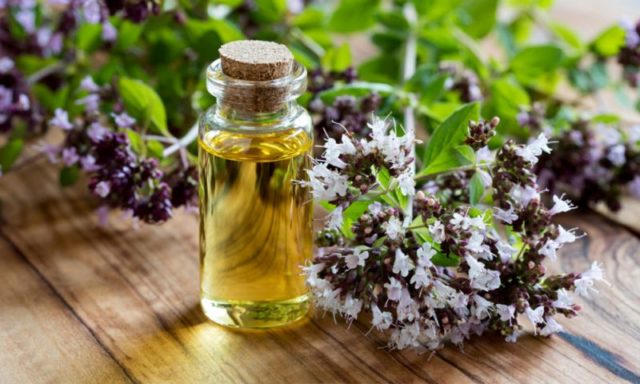
Infusion
To prepare the medicinal infusion, pour boiling water over 4 small spoons of chopped seasoning and leave under the lid for 15 minutes. The finished product is filtered and drunk four times a day on an empty stomach, 50 ml. The infusion helps with neuralgic pains and bowel diseases.
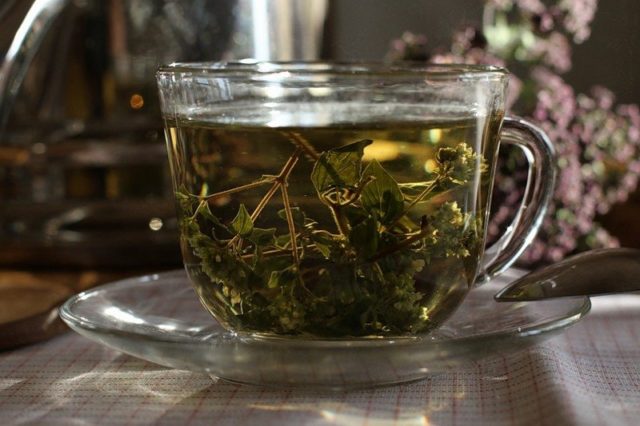
The use of marjoram seasoning for medicinal purposes
Seasoning medicines are used for a variety of ailments. Traditional medicine offers several recipes to promote health.
Marjoram oil tea for headaches
For migraines and a tendency to hypertension, you can add 1-2 drops of ether per cup of tea. The medicinal properties of marjoram relieve vascular spasms and alleviate the condition, but you need to consume the oil internally no more often than once a day.
Marjoram infusion for gastrointestinal diseases
For chronic gastritis, slow digestion and a tendency to constipation, you can use the following remedy:
- 15 g of dried seasoning is steamed with a glass of hot water;
- insist 3 hours, and then filter;
- divide the drink into 3 equal portions.
You need to drink the infusion on an empty stomach shortly before meals for 3 weeks. Every day, the medicinal drink is prepared anew.
Inhalation with marjoram for colds
With a runny nose, cough and bronchitis, it is useful to inhale the healing vapors of the spice plant. You need to boil a small saucepan of water, then throw a pinch of dried seasoning into it, and then bend over the container and breathe in the steam for 5-10 minutes. Inhalation is carried out daily until complete recovery.

Marjoram ointment for joint diseases
Homemade ointment helps with arthritis, rheumatism and osteochondrosis. One of the recipes looks like this:
- a small bunch of fresh marjoram or dry seasoning is ground in a mortar to a state of gruel;
- mixed with ordinary petroleum jelly in a cream jar until completely homogeneous;
- rubbing sore spots twice a day.
Healing ointment is prepared in small portions, since even in the refrigerator it retains its benefits for only 3 days.
Marjoram with honey for insomnia
For sleep disorders, you can add 3 drops of oil to 1 small spoonful of honey. The remedy is taken three times a day, the last portion should be consumed in the evening. Marjoram has a pronounced calming effect and helps to improve the quality of your night's rest.
Marjoram infusion to strengthen immunity
In the season of viral diseases, it is especially useful to take an infusion of dried marjoram. Pour a large spoonful of seasoning with 250 ml of hot water, cover and leave for 5 minutes.
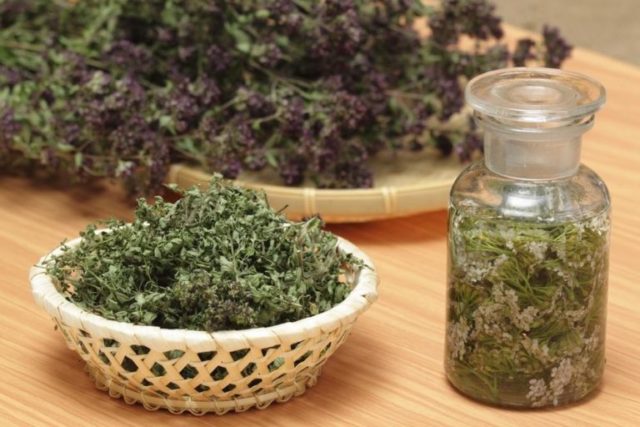
The finished product is filtered from the sediment and drunk in small sips, no more than 2 cups a day. The beneficial substances in the seasoning strengthen the immune system and help protect against colds.
The use of spices in cosmetology
Marjoram essential oil and herbal infusions are used for skin and hair care. The seasoning helps to tighten pores and regulate the oiliness of the epidermis, strengthens hair and removes dandruff.
Use cases in cosmetology:
- Spicy herb can be added to face and hand creams, and made into nail baths.
- The condiment broth can be frozen to the state of ice cubes and wiped on the skin in the morning, such washing will help tone and rejuvenate the epidermis.
- For the treatment of acne and blackheads, marjoram juice is well suited, fresh leaves are thoroughly crushed, and then for 10 minutes the problem areas are lubricated with the emerging liquid.
The beneficial properties of the seasoning are good for the hair.With weakened and dull curls, you can add 2 drops of ether to regular shampoo or rinse the strands with an aromatic broth.
The use of a spice for weight loss
The fragrant seasoning is often used in nutritional medicine for weight loss. Marjoram improves metabolism and prevents the accumulation of fatty deposits, as well as soothes and helps fight stress from dietary restrictions. The seasoning has a mild laxative effect and also helps to flush excess water from the body.
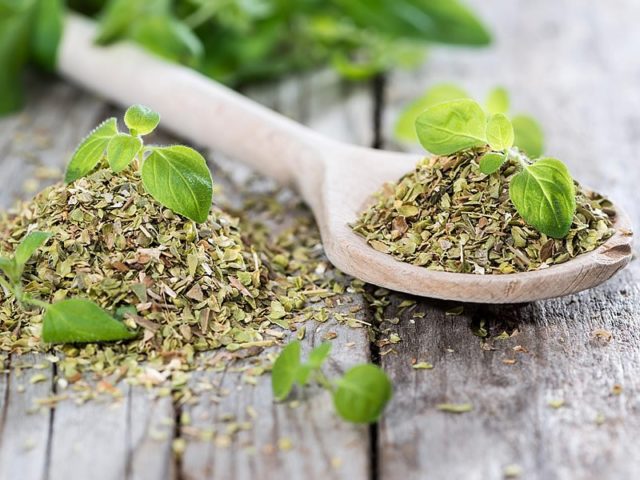
It is very simple to use spice on a diet, it is added to ordinary low-fat dishes. At the same time, it is better to use fresh grass for salads and snacks, and dried herbs for soups and side dishes. Benefits are brought by teas and decoctions with the addition of seasoning, if you drink them shortly before meals, marjoram will help muffle your appetite.
The use of marjoram in cooking
The seasoning is completely versatile and goes well with almost any dish. At low dosages, the herb enriches the taste of food and gives it a pleasant aroma.
What dishes is marjoram seasoning suitable for
Fresh and dried herb stimulates the digestion process and helps the body deal with “heavy” foods faster. Therefore, it is especially recommended to add it to lamb and pork, fried sausages and sausages, to baked ham and marinade for barbecue.
Also seasoning is used:
- for salads, soups and sauces, both dried and fresh;
- to improve the taste and aroma of meat dishes, the spice goes especially well with cloves;
- to decorate pizza or meat pastries;
- in the preparation of vinegar for pickles.
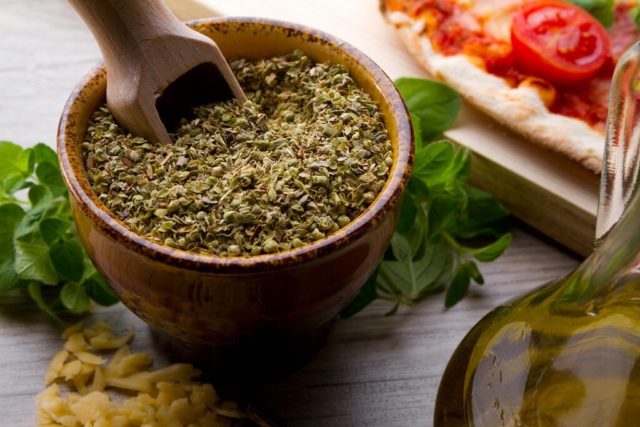
Marjoram can be added to sauces, as well as pea, bean, and potato soups. Fresh leaves are often placed in green or black tea, the drink acquires very pleasant citrus-woody notes.
What can be replaced
If marjoram is not at hand, you can look for a replacement among other spices. A similar taste and aroma are possessed by:
- oregano, or oregano;
- thyme;
- rosemary;
- mint combined with cumin.
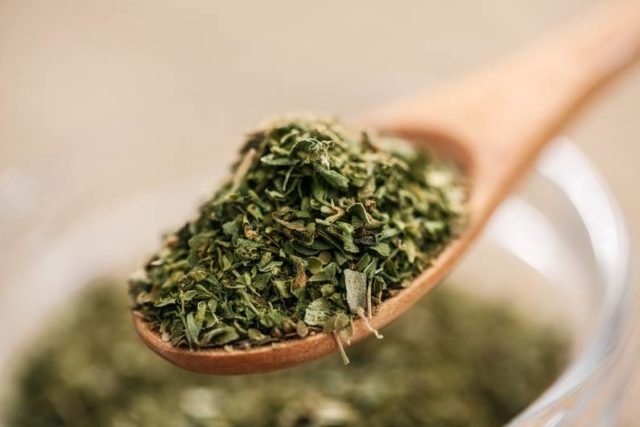
The seasoning is often included in ready-made mixtures, for example, it can be found in Provencal herbs, utskho-suneli or hop-suneli.
If you cannot use a spice for cooking due to individual intolerance, then you must also be careful when choosing a replacement. It is necessary to familiarize yourself with the features and composition of similar seasonings and understand whether they will harm the body.
Contraindications to the use of marjoram herb
The benefits and harms of marjoram are not always the same; for all its valuable properties, the seasoning has some contraindications. It is not recommended to use it:
- if you have an individual allergy;
- with increased blood clotting;
- with varicose veins and a tendency to vascular thrombosis;
- with hypotension;
- in acute poisoning and intestinal disorders;
- with nausea and dizziness.
Pregnant women and nursing mothers need to stop using the spice.
How to choose and store
When buying marjoram in any form, you need to pay attention to the quality of the seasoning:
- Fresh bunches of fragrant herbs should be completely intact, without holes or torn edges. You should not buy the product if there are dark or yellow spots on the leaves, such a spice will not bring much benefit.
 Fresh marjoram leaves should be juicy and whole
Fresh marjoram leaves should be juicy and whole - Dried marjoram is recommended to be purchased in sealed containers from a trusted brand. When choosing, you need to pay attention to the date of manufacture and expiration date, the product is stored for a long time, but not indefinitely. If the seasoning is sold open, you need to make sure that it has a bright spicy aroma with a bittersweet note.
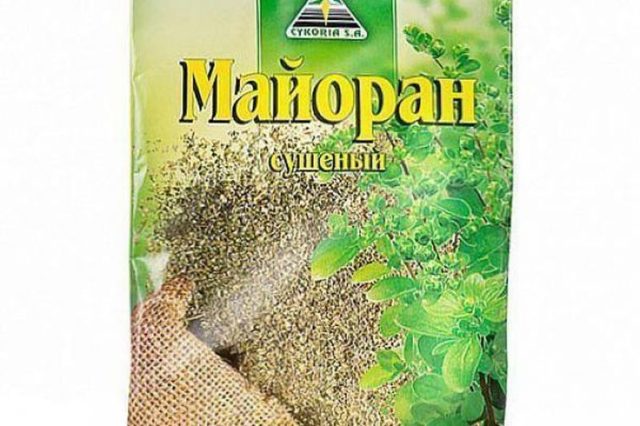 When buying dried marjoram you need to look at the expiration date
When buying dried marjoram you need to look at the expiration date
Fresh seasoning leaves retain their valuable properties for a short time. They can be kept on the bottom shelf of the refrigerator for only 4 days, then they will begin to fade.
The dried seasoning remains usable throughout the year. It should be stored in a sealed glass or ceramic container at room temperature, away from direct light and at low humidity.
Conclusion
The beneficial properties of marjoram and contraindications are related to each other, but most people can use the seasoning. The aromatic herb not only improves the taste of ordinary dishes, but also has a beneficial effect on health.
Reviews of marjoram for weight loss

